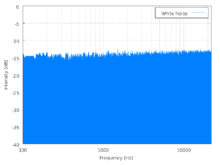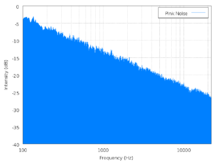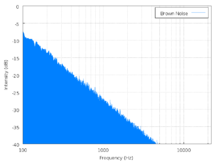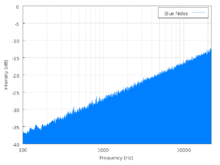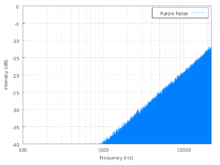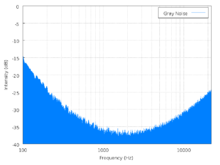- Colors of noise
-
Colors of noise White Pink Red (Brownian) Grey While noise is by definition derived from a random signal, it can have different characteristic statistical properties corresponding to different mappings from a source of randomness to the concrete noise. Spectral density (power distribution in the frequency spectrum) is such a property, which can be used to distinguish different types of noise. This classification by spectral density is given "color" terminology, with different types named after different colors, and is common in different disciplines where noise is an important factor (like acoustics, electrical engineering, and physics). However, different fields may use the terminology with different degrees of specificity.
Contents
Power-law noise
Many of these definitions assume a signal with components at all frequencies, with a power spectral density per unit of bandwidth proportional to 1/f β and hence they are examples of power-law noise. For instance, the spectral density of white noise is flat (β = 0), while flicker or pink noise has β = 1, and brown noise has β = 2.
Technical definitions
Various noise models are employed in analysis, many of which fall under the above categories. AR noise or "autoregressive noise" is such a model, and generates simple examples of the above noise types, and more. The Federal Standard 1037C Telecommunications Glossary[citation needed] defines white, pink, blue, and black.
The color names for these different types of sounds are derived from a loose analogy between the spectrum of frequencies of sound wave present in the sound (as shown in the blue diagrams) and the equivalent spectrum of light wave frequencies. That is, if the sound wave pattern of "blue noise" were translated into light waves, the resulting light would be blue, and so on.
White noise
White noise is a signal (or process), named by analogy to white light, with a flat frequency spectrum [1]. In other words, the signal has equal power in any band of a given bandwidth (power spectral density). For example, with a white noise audio signal, the range of frequencies between 40 Hz and 60 Hz contains the same amount of sound power as the range between 4000 Hz and 4020 Hz has.
Pink noise
The frequency spectrum of pink noise is linear in logarithmic space; it has equal power in bands that are proportionally wide.[1][2] This means that pink noise would have equal power in the frequency range from 40 to 60 Hz as in the band from 4000 to 6000 Hz. Since humans hear in such a proportional space, where a doubling of frequency (an octave) is perceived the same regardless of actual frequency (40–60 Hz is heard as the same interval and distance as 4000–6000 Hz), every octave contains the same amount of energy and thus pink noise is often used as a reference signal in audio engineering. The power density, compared with white noise, decreases by 3 dB per octave (density proportional to 1/f ). For this reason, pink noise is often called "1/f noise".
Since there are an infinite number of logarithmic bands at both the low frequency (DC) and high frequency ends of the spectrum, any finite energy spectrum must have less energy than pink noise at both ends. Pink noise is the only power-law spectral density that has this property: all steeper power-law spectra are finite if integrated to the high-frequency end, and all flatter power-law spectra are finite if integrated to the DC, low-frequency limit.
Brown(ian) noise
In fields that adopt precise definitions, the terminology "red noise", also called Brown noise or Brownian noise, will usually refer to a power density which decreases 6 dB per octave with increasing frequency (density proportional to 1/f 2)[1] over a frequency range which does not include DC (in a general sense, does not include a constant component, or value at zero frequency). In areas where terminology is used loosely, "red noise" may refer to any system where power density decreases with increasing frequency.[3]
The first definition can be generated by an algorithm which simulates Brownian motion or by integrating white noise. "Brown" noise is not named for a power spectrum that suggests the color brown; rather, the name is a corruption of Brownian motion. "Red noise" describes the shape of the power spectrum, with pink being between red and white. Also known as "random walk" or "drunkard's walk" noise.
Blue noise
Blue noise is also called azure noise. Blue noise's power density increases 3 dB per octave with increasing frequency (density proportional to f ) over a finite frequency range.[1][4] In computer graphics, the term "blue noise" is sometimes used more loosely as any noise with minimal low frequency components and no concentrated spikes in energy. This can be good noise for dithering.[5] Retinal cells are arranged in a blue-noise-like pattern which yields good visual resolution.[6][5]
Violet noise
Violet noise is also called purple noise. Violet noise's power density increases 6 dB per octave with increasing frequency[1][7][8] (density proportional to f 2) over a finite frequency range. It is also known as differentiated white noise, due to its being the result of the differentiation of a white noise signal.
Grey noise
Grey noise is random white noise subjected to a psychoacoustic equal loudness curve (such as an inverted A-weighting curve) over a given range of frequencies, giving the listener the perception that it is equally loud at all frequencies.[citation needed] This is in contrast to standard white noise which has equal strength over a linear scale of frequencies but is not perceived as being equally loud due to biases in the human equal-loudness contour.
Unofficial colors
There are also many "unofficial" colors, usually with multiple definitions.
Red noise
- A synonym for Brownian noise, as above[9]
- A synonym for pink noise, as above[10]
Orange noise
Orange noise is quasi-stationary noise with a finite power spectrum with a finite number of small bands of zero energy dispersed throughout a continuous spectrum. These bands of zero energy are centered about the frequencies of musical notes in whatever scale is of interest. Since all in-tune musical notes are eliminated, the remaining spectrum could be said to consist of sour, citrus, or "orange" notes.[11]
Green noise
- "Green noise is supposedly the background noise of the world. A really long term power spectrum averaged over several outdoor sites. Rather like pink noise with a hump added around 500 Hz."[11]
- The mid-frequency component of white noise, used in halftone dithering[12]
- Bounded Brownian noise
Black noise
Black noise is also called silent noise.
- Silence[1]
- Noise with a 1/fβ spectrum, where β > 2 (Manfred Schroeder, "Fractals, chaos, power laws"). Used in modeling various environmental processes.[11]
- Noise that has a frequency spectrum of predominantly zero power level over all frequencies except for a few narrow bands or spikes. Note: An example of black noise in a facsimile transmission system is the spectrum that might be obtained when scanning a black area in which there are a few random white spots. Thus, in the time domain, a few random pulses occur while scanning.[13]
- "The output of an active noise control system which cancels an existing noise, leaving the local environment noise free. The comic book character Iron Man used to have a "black light beam" that could darken a room in this manner, and popular science fiction has a tendency to portray active noise control in this light."[11] The Batman Beyond supervillian Shriek also had a weapon like this, which effectively blocked out all noise.[citation needed]
- "As seen in the sales literature for an ultrasonic vermin repeller, black noise with a power density that is constant for a finite frequency range above 20 kHz. More accurately, ultrasonic white noise. This black noise is like the so-called black light with frequencies too high to be sensed, but still capable of affecting the environment."[11]
- Noise with a spectrum corresponding to the blackbody radiation (thermal noise).
Noisy white
In telecommunication, the term noisy white has the following meanings:[14]
- In facsimile or display systems, such as television, a nonuniformity in the white area of the image, i.e., document or picture, caused by the presence of noise in the received signal.
- A signal or signal level that is supposed to represent a white area on the object, but has a noise content sufficient to cause the creation of noticeable black spots on the display surface or record medium.
Noisy black
In telecommunication, the term noisy black has the following meanings:[15]
- In facsimile or display systems, such as television, a nonuniformity in the black area of the image, i.e., document or picture, caused by the presence of noise in the received signal.
- A signal or signal level that is supposed to represent a black area on the object, but has a noise content sufficient to cause the creation of noticeable white spots on the display surface or record medium.
See also
References
- ^ a b c d e f Definition of "noise color" - Rane Pro Audio Reference
- ^ Definition of "pink noise" - Federal Standard 1037C
- ^ Daniel L. Rudnick, Russ E. Davis (2003). "Red noise and regime shifts". Deep-Sea Research I 50 (6): 691–699. Bibcode 2003DSRI...50..691R. doi:10.1016/S0967-0637(03)00053-0. http://www-pord.ucsd.edu/~rdavis/publications/Red_Noise.pdf.
- ^ Definition of "blue noise" - Federal Standard 1037C
- ^ a b Mitchell, Don P., "Generating Antialiased Images at Low Sampling Densities." Computer Graphics, volume 21, number 4, July 1987.
- ^ Yellott, John I. Jr., "Spectral Consequences of Photoreceptor Sampling in the Rhesus Retina." Science, volume 221, pp. 382-385, 1983. PMID 6867716
- ^ Transactions of the American Society of Heating, Refrigerating and Air-Conditioning Engineers 1968 [1] Quote: 'A "purple noise," accordingly, is a noise the spectrum level of which rises with frequency.'
- ^ Estimating double difference GPS multipath under kinematicconditions. Zhang, Q.J. and Schwarz, K.-P.. Position Location and Navigation Symposium, p. 285-291. Apr 1996. 10.1109/PLANS.1996.509090 "The spectral analysis shows that GPS acceleration errors seem to be violet noise processes. They are dominated by high-frequency noise."
- ^ Index: Noise (Disciplines of Study [DoS])
- ^ http://oak.cats.ohiou.edu/~cuddingt/pubs/proceedings99.pdf
- ^ a b c d e Joseph S. Wisniewski (7 October 1996). "Colors of noise pseudo FAQ, version 1.3". comp.dsp. (Web link). Retrieved 2011-03-01.
- ^ Green-Noise Digital Halftoning
- ^ Definition of "black noise" - Federal Standard 1037C
- ^ Definition of "noisy white" - Federal Standard 1037C
- ^ Definition of "noisy black" - Federal Standard 1037C
 This article incorporates public domain material from the General Services Administration document "Federal Standard 1037C".
This article incorporates public domain material from the General Services Administration document "Federal Standard 1037C".External links
Noise (in physics and telecommunications) General Noise in... Class of noise Additive white Gaussian noise (AWGN) · Atmospheric noise · Background noise · Brownian noise · Burst noise · Cosmic noise · Flicker noise · Gaussian noise · Grey noise · Jitter · Johnson–Nyquist noise · Pink noise · Quantization error (or q. noise) · Shot noise · White noiseEngineering terms Ratios Carrier-to-noise ratio (C/N) · Carrier-to-receiver noise density (C/kT) · dBrnC · Eb/N0 (energy per bit to noise density) · Es/N0 (energy per symbol to noise density) · Modulation error ratio (MER) · Signal, noise and distortion (SINAD) · Signal-to-interference ratio (S/I) · Signal-to-noise ratio (S/N, SNR) · Signal to noise ratio (imaging) · Signal-to-noise plus interference (SNIR) · Signal-to-quantization-noise ratio (SQNR)Related topics List of noise topics · Colors of noise · Interference (communication) · Radio noise source · Spectrum analyzer · Thermal radiationTimbre Colors of noise · Fundamental frequency · Loudness · Microinflection · Noise · Pitch · Rustle noise · Spectral envelope · TonalityCategories:- Noise
- Encodings
Wikimedia Foundation. 2010.

